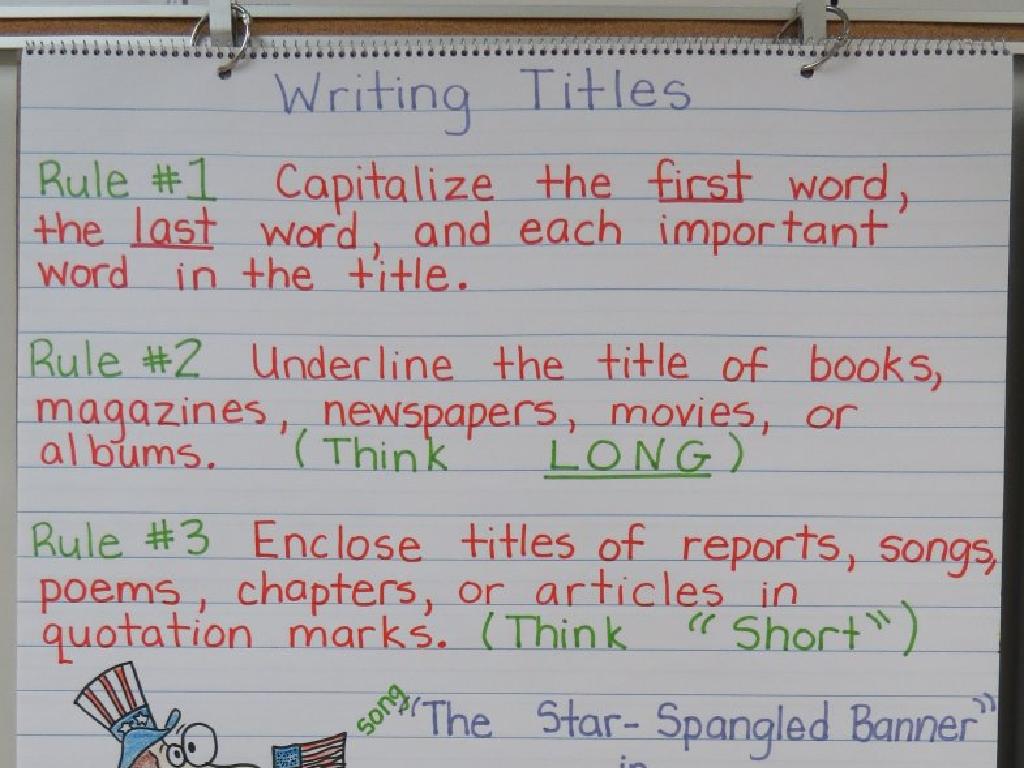Create Line Graphs
Subject: Math
Grade: Fifth grade
Topic: Data And Graphs
Please LOG IN to download the presentation. Access is available to registered users only.
View More Content
Today’s Adventure: Creating Line Graphs!
– Visualizing data with line graphs
– Line graphs show data over time, like your height as you grow!
– Reasons we use graphs
– Graphs make it easy to see and compare information
– Steps to create a line graph
– Gather data, choose a scale, plot points, then connect them
– Practice with real data
– We’ll use class survey data to make our own line graph
|
This slide introduces the concept of line graphs as a tool for visualizing data, particularly how things change over time. Emphasize the importance of graphs in making complex data understandable and highlight the key steps in creating a line graph: collecting data, choosing an appropriate scale for the graph, plotting the data points accurately, and connecting them to show trends. Encourage students to think of examples where they have seen graphs used in real life. The practice activity will involve using real data from a class survey to create a line graph, reinforcing the lesson and providing hands-on experience.
Understanding Line Graphs
– What is a line graph?
– A chart to visualize data points connected by lines
– Displays data over time
– Like tracking temperature changes through the week
– Shows trends with lines
– Helps us see if things increase, decrease, or stay the same
– Where have you seen a line graph?
|
Begin the lesson by explaining what a line graph is and its purpose. Emphasize that it’s a tool used to display data changes over intervals of time, which helps in identifying trends. Show examples of line graphs, such as temperature changes over a week or a student’s grades throughout the school year. Ask the class if they can think of any examples where they have seen a line graph in real life to encourage participation and connect the concept to their daily experiences. This will help students understand the practical application of line graphs and prepare them for creating their own.
Parts of a Line Graph
– Title: What the graph displays
– Like a book title, it tells us the graph’s story.
– X-axis: Time period or categories
– Horizontal line with labels, e.g., ‘Days of the Week’.
– Y-axis: Values or measurements
– Vertical line with numbers, e.g., ‘Amount of Rain’.
– Data Points: Actual values shown
– Marks at the intersection of X and Y values.
– Lines: Trends over time or categories
– Connects points to highlight increase or decrease.
|
This slide introduces the essential components of a line graph, which is a powerful tool for displaying data trends over time or across different categories. The title of the graph sets the context for the data being presented. The X-axis typically represents the time period or categories being compared, while the Y-axis shows the numerical values or measurements. Data points are plotted on the graph where the X and Y values meet, and lines are drawn to connect these points, making it easier to visualize the data trend. Encourage students to think of a line graph as a story, with the title as the headline and the lines as the plot showing the rise and fall of the values over time.
Reading Line Graphs
– Understanding the X and Y axes
– X-axis usually shows time, Y-axis shows what we measure
– Identifying data points
– Points where the line meets the grid
– Interpreting data point meaning
– Each point shows a value for a certain time
– Recognizing change over time
– The slope of the line indicates increase or decrease
|
This slide is aimed at teaching students how to read and interpret line graphs. Start by explaining the axes: the X-axis (horizontal) typically represents time, while the Y-axis (vertical) represents the quantity or value being measured. Show how individual data points are plotted on the graph where the line intersects with the grid. Discuss how each data point reflects a specific measurement at a given time. Then, demonstrate how the line’s direction and steepness illustrate changes over time, such as growth or decline. Use examples relevant to fifth graders, like tracking daily temperatures or class test scores over a school term, to make the concept relatable.
Creating Our Line Graph
– Step 1: Collect and organize data
– Gather information and arrange it in order
– Step 2: Draw and label axes
– Create horizontal (X-axis) and vertical (Y-axis) lines with proper labels
– Step 3: Plot data points
– Mark the data points accurately on the graph
– Step 4: Connect the points
– Draw lines to join the points in sequence
|
This slide guides students through the process of creating a line graph. Start by collecting data from an experiment or survey and organize it in a table. Next, draw the X and Y axes on graph paper and label them with the variables being measured. Carefully plot each data point on the graph where the X and Y values meet. Then, connect the data points with straight lines to show the trend. Finally, give your graph a descriptive title and double-check that all the data is plotted correctly. Encourage students to be precise in their plotting and to use a ruler for straight lines. This activity will help them understand how to visually represent data and interpret trends.
Analyzing Our Reading Habits with Line Graphs
– Our class’s weekly reading data
– Visualizing daily reading on a line graph
– A line graph shows the books we read each day
– Observing trends in our reading routine
– Does the line go up or stay the same?
– Discussing our reading progress
– Share what you think about our reading trends
|
This slide is designed to help students understand how to create and interpret line graphs using real data from their own classroom reading habits. Start by showing the data collected on the number of books or pages the class has read each day over the past week. Then, display this data on a line graph, pointing out how each day is plotted and how the line connects these points. Ask the students to observe the graph and notice any trends, such as an increase in reading towards the end of the week or consistent reading habits. Encourage them to think about why these trends might occur and what it says about their reading habits. This will not only teach them how to read and create line graphs but also promote reflection on their learning process.
Let’s Practice Together: Creating Line Graphs
– Create a line graph with fun data
– Plot points as a team
– Each student will plot a point on the graph
– Draw lines to connect points
– Use a ruler to draw straight lines
– Analyze the graph’s story
– What trends do we see?
|
This slide is for a class activity where students will engage in creating a line graph from provided data. The data set should be interesting and relatable to the students, such as favorite ice cream flavors over months or hours spent on homework during the week. The teacher will guide the students through plotting each data point on the graph and then connecting these points with lines. After completing the graph, the class will discuss what the graph reveals about the data, such as trends, peaks, and lows. The teacher should prepare different data sets so that students can work in small groups, allowing for a more hands-on experience. The activity will help students understand how line graphs visualize data and the stories they can tell.
Class Activity: Graph Your Own Screen Time!
– Track screen time for one week
– Plot data on the graph template
– Use hours or minutes as units on your graph
– Share and discuss graphs with a partner
– Explain your daily screen time trends
– Reflect on your screen time habits
– Think about how much time you spend and when
|
This activity is designed to help students understand how to create and interpret line graphs by using personal data that is relevant to them. Students will track their own screen time over the course of a week, which will engage them in both data collection and analysis. Provide a graph template with time slots and days of the week for students to use. Encourage them to be accurate in their tracking and plotting. After creating their graphs, students will pair up to compare their screen time and discuss any patterns or surprises they notice. This will foster communication skills and critical thinking. As a teacher, guide the discussion towards healthy screen time habits and the importance of balancing activities. Possible variations of the activity could include tracking different types of activities, such as reading or outdoor play, to compare with screen time.
Conclusion & Reflection on Line Graphs
– Recap of line graph learning
– Daily uses of line graphs
– Visualizing trends like temperature changes or savings over time.
– Open floor for questions
– Share interesting observations
|
As we wrap up today’s lesson, let’s reflect on what we’ve learned about line graphs. They are powerful tools for displaying data in a way that makes it easy to see trends and changes over time. We’ve seen how they can be used in various aspects of daily life, such as tracking the weather or monitoring our own savings. Now, I’d like to open the floor for any questions you might have or if you’d like to share any interesting observations you’ve made during today’s activities. This is also a great time to encourage students to think about how they can apply what they’ve learned when they encounter data in their own lives.





